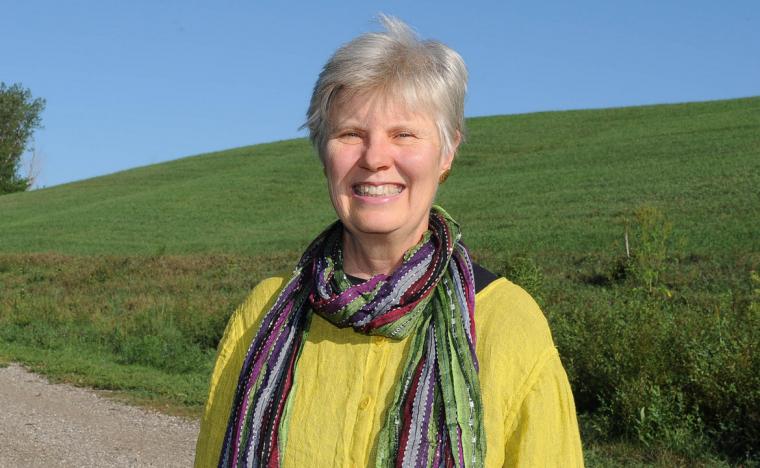
Mary Swander, BEI Senior Fellow, recently was featured in the Des Moines Register with an article written about her effort to bring information about COVID-19 to the Amish. Read the original article here or keep scrolling.
In eastern Iowa, concerned neighbors take steps to ensure Amish get word about COVID-19
A conversation with one of her Amish neighbors near Kalona left Mary Swander feeling uneasy.
It was March 13, five days after Iowa announced its first COVID-19 patient, and the elderly man Swander was speaking with seemed unaware of the pandemic that was just then creeping into Iowa. The longer they spoke, the more her worry grew — for her friend and the other 1,200 Amish residents in Johnson and Washington counties.
Swander decided to talk to a few more people at a store that caters to Amish customers. That confirmed her fears.
“They had a vague inkling about it, but they were kind of making a joke out of it. And that’s what got me really concerned, because without TV, radio, internet, they wouldn’t know how bad it is,” Swander said.
“They were kind of half taking me seriously and half-thinking I was alarmist. I could feel that tension.”
The Amish started as a Christian sect that arose in Switzerland and Germany in the 16th century as part of a schism with the Catholic Church. They arrived in Kalona in 1846 and have eschewed modern technology, from automobiles to telephones. They maintain a traditional lifestyle in the clothing they wear and in the way they worship, farm and educate their children.
But they are far from isolated.
Amish horses and buggies are ubiquitous around Kalona, an eastern Iowa town of about 2,500, as they ride to town to shop or bank or attend auctions. There are local car chauffeurs who make a living bringing Amish people into Iowa City, where Menards and Walmart are popular stops. The Amish will rent buses or vans for trips to Indiana or Ohio for weddings and funerals, Swander said. Lacking health insurance, they will travel by train to Mexico if they need a major medical procedure.
Swander is a retired professor, an author and a poet. She has lived among the Amish and studied them for 30 years. Her house used to be a one-room schoolhouse used by Amish families.
From her window last week, she could see Amish children still riding their bicycles to attend their current school.
Swander knew what exposure to the coronavirus could mean for a segment of society that hadn’t gotten the word about social distancing.
“They’re a very communal culture, so they have these large gatherings, especially weddings and funerals. And they have church in their homes, so they might have like 200 people in their house for church or their barn or their basement,” Swander said.
“They have their own businesses as blacksmiths or wheelwrights or doing concrete work. They all have customers coming to their farm from the outside world.”
A Register reporter’s attempts to reach members of the Amish community were unsuccessful. It’s a community that typically shuns attention of any sort.
On March 15, Swander made copies of the latest information about COVID-19 from the Centers for Disease Control. She placed those in the mailboxes of as many Amish families as she could.
But she wanted to do more. She called her friend, Stephanie Leonard, who has lived for two decades among the Amish in nearby Riverside.
Leonard is an industrial hygienist by trade who was already isolating herself against the coronavirus. She, too, grew alarmed when she thought about how to get the message to her Amish friends about the severity of the public health threat.
“They’ve got grandparents living on the same farm and sometimes in the same home. So there would be an easy spread among age ranges if it took hold. It’s very worrisome,” Leonard said.
“They wouldn’t know how to call in to get screenings from clinics. They wouldn’t have the ease of getting to the hospital. That’s all part of the concern and compounding them being a risk population that’s vulnerable.”
Leonard reached out to the Johnson and Washington county health departments, asking if there was any way their personnel could communicate with the nine distinct Amish communities in their midst.
Danielle Pettit-Majewski fielded Leonard’s call in Washington County. She, too, had recently begun to think about how to educate a group of citizens that can be shut off from the outside world. She thought about how quickly a measles outbreak spread among Orthodox Jews in New York a year ago.
Pettit-Majewski told her counterpart in Johnson County that she would handle the situation, since that county has been the hardest hit in Iowa by COVID-19 cases so far. She felt she had a good relationship with the Amish population. She provides vaccines to the children each year.
Amish households don’t have telephones, but each community typically has one phone booth that will be checked for messages daily. Each has a bishop as well. Pettit-Majewski left a voicemail for one bishop, who returned the call and listened to her message about the importance of limiting sizes of groups to 10, of washing hands frequently, about maintaining at least 6 feet of space from other people and about how vulnerable the elderly and those with underlying health issues are to the coronavirus.
She told him Gov. Kim Reynolds had recommended the temporary closure of schools throughout Iowa.
That, in particular, seemed to resonate. That bishop put Pettit-Majewski in touch with others.
“They were very amenable to wanting to make sure that they kept their communities safe,” Pettit-Majewski said.

